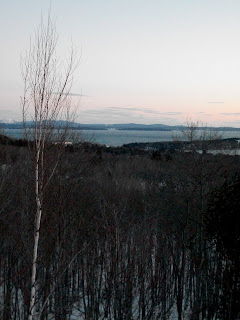
Island view from Cadillac Mountain


Despite the frosty weather, it made for one of the clearest nights yet beheld by us in Maine. And it was far too cold for any ghosts to be wandering from the snow covered graves.

Mike inspecting our green igloo

I don't think I was still smiling when it got to 2 degrees...
We awoke from our icy tomb/two person tent, proceeded immediately to the mini-van and blasted the heat. We warmed up just in time to go back outside into the cold wind and begin hiking Cadillac Mountain. The mountain is the highest point along the eastern seaboard, and thus receives the first glint of sunlight in the United States throughout most of the year. It was named for a man who swindled a Canadian governor into the land rights, naming it Cadillac Mountain under his fantasy for ruling the Land of Cadillac. He made it one year with his wife before tiring of his make-believe kingdom, going on to found the city of Detroit in Michigan (thus, the cadillac automobile is named after him and carries his invented coat of arms insignia). With the exception of two snowmobiles, we were alone on the mountain and watched the sun creep up over the ocean.


The island itself is a patchwork of national park lands and private lands, interspersed with several towns. Acadia National Park encompasses about 45,000 acres, distributed between Mt. Desert Island, Isle au Haut, several smaller islands, and part of the mainland. The landscape is ruggedly eroded and ancient in appearance, having been beaten down by glaciers coming and going over time. the result is a varied land with forests, meadows, wetlands, the ocean (of course), mountains and the only natural fjord in the lower 48 states.

Dawns first light on Eagle Lake

Looking for snow spirits

Evidence of evolution
Most of the park was frozen from our view, though, with areas closed off for the winter. The sacrifice of not seeing all of the park was gaining the solitude of the island. We may as well have had the park to ourselves, with the exception of some locals we very occasionally ran into cross-country skiing or snowshoeing. To go to Acadia in the winter is to have a quiet, meditative experience and see a face of Acadia most tourists never see. Being one of the top ten most visited national parks in the country, and subject to traffic jams from over crowding in the summer, winter was the way to go.

Bass Harbor

Bass Harbor Headlight

Picturesque...
